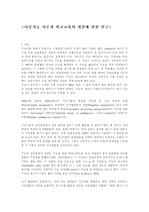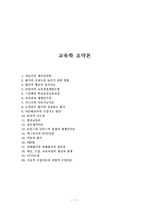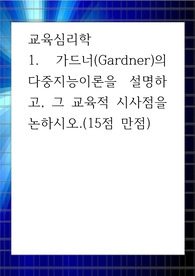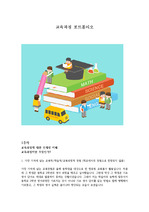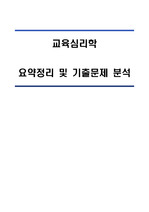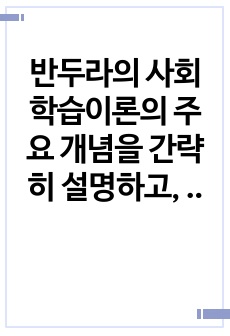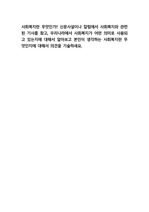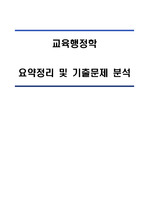

-
미리보기
소개
다중이론과 학교교육의 개선방안목차
I. 서론
II. 다중지능 이론
1. 이론적 배경
2. 측정
3. 다중지능 이론의 비판
III. 교육적 시사
1. 수업에의 적용
2. 학교교육의 개선
IV. 결론본문내용
I. 서론
지능이론 중에서 다중지능 이론만큼 교육적 시사가 많은 이론은 없다. Gardner는 8가지 근거에 의해 심리측정적 관점과 학교에서 전통적으로 강조되어 온 언어지능과 논리-수리 지능 외에 음악지능, 공간지능, 운동감각 지능, 개인지각 지능, 대인관계 지능, 자연관찰 지능, 실존지능을 더하여 9가지로 지능을 분류하였다. 각 지능이 나타나는 정도는 개인마다 다르기 때문에 학생별로 우수한 지능을 발견하여 이 지능을 활용하여 가르칠 경우 수업효과가 높아진다. 이 이론에 근거한 수업을 실시할 때 문제점은 학급 크기 및 학생별로 우수한 지능을 어떻게 발견하는가 하는 측정문제와 서로 다른 지능의 표현 형태로 수업내용을 재구성하는 교사의 창의성과 많은 수업준비 시간이 필요하다는 것이다. 다중지능 이론 수업의 성패는 교육과정의 구성, 평가형태, 교육의 주변 문화에 달려 있다.
지능이 연구되기 시작한 이후 지금까지 100년 동안 그 질과 양에서 많은 발전을 하여 지능의 정의를 한가지로 말하기가 어렵게 되었다. 지능의 정의가 이렇게 다양하기는 하나 지능을 보는 관점은 크게 네가지로 구분할 수 있다.
1900년대 초부터 1950년대까지 지능이론과 측정을 주도해 온 심리 측정적 관점(Psychometric perspective), 피아제의 인지발달론적 관점(Piagetian perspective), 인지 심리학의 발달에 따라 정보 처리론적 관점(information processing perspective)에서 지능을 규명하려는 Sternberg의 3원이론(Triarchic theory of intelligence), 그리고 Gardner의 다중지능 이론(Multiple intelligences theory)이다.
지능이론은 교육현장에서 교육 효과를 높이기 위해 활용될 수 있어야 한다. 본 연구는 심리측정적 관점과 인지발달론적 관점, 삼원이론에서는 학교 교육의 효과를 높이기 위한 방안이나 시사점을 찾기가 쉽지 않다는 전제 아래(심우엽, 1995), 다중지능 이론에서 그 대안을 찾아 보고자 한다. 먼저 앞의 세 지능이론의 문제점들을 간략히 정리하고 다중지능 이론의 이론적 배경과 측정 문제를 살펴 볼 것이다. 그리고 다중지능 이론의 비판과 문제점을 논의한 후 이 이론의 교육적 시사점들을 정리하고자 한다.
지능의 심리측정적 관점은 지능을 일반 학습능력으로 보고 지필검사 등의 표준화된 검사를 만들어 개인차를 변별하는데는 성공하였으나 그 개인차가 학습자에게 교육적으로 도움이 될 기회는 별로 없다. 이 관점은 단일 요인으로 일반 지능 g 를 가정하고, 지능의 유전계수(heritability ratio, h2)를 예로 들어(흔히 .3 ~ .7로 보고됨) 일반 지능의 생물학적 근거(즉 유전)를 가정하며, 전통적인 지능 검사(IQ tests)가 지능을 잘 측정하고 있다고 본다. 그러나 이러한 세가지 가정은 많은 비판을 받고 있다(Ceci & Bruck, 1994).참고자료
· 심우엽 (1995). 지능의 관점과 교육적 시사. 초등교육연구, 9. 33-48.
· Armstrong, T. (1994). Multiple intelligences in the classroom. Alexandria, VA:Association for Supervision and Curriculum Development.
· Balwin, A.Y. (1994). The seven plus story: Developing hidden talent among students in socioeconomically disadvantaged environments. Gifted Child Quarterly, 38(2). 80-84.
· Bellanca, J., Chapman,C., & Swartz, E. (1994). Multiple assessments for multiple intelligences. Palatine, IL: Skylight Publishing Inc.
· Campbell, L., Campbell, B., & Dickinson, D. (1996). Teaching & learning through multiple intelligences. Needham Heights, MA: Allyn & Bacon.
· Ceci, S.J., & Bruck, M. (1994). The bio-ecological theory of intelligence: A developmental-contextual perspective. In D.K. Detterman (Ed.), Theories of intelligence (Current topics in human intelligence, Vol. 4). Norwood, NJ:Ablex Publishing Corporation. 65-84.
· Ceci, .J., Ramey, S.L., & Ramey, C.T. (1990). Framing intellectual assessment in terms of a person-process-context model. Educational Psychologist, 25(3&4). 269-291.
· Csikszentmihalyi, M., Rathunde, K., & Whalen, S. (1993). Talented teenagers:The roots of success and failure. NY: Cambridge University Press.
· Davidson, J.E. (1990). Intelligence recreated. Educational Psychologist, 25(3&4). 337-354.
· Eisner, E.W. (1994). Multiple intelligences:The theory in practice by Howard Garder. Teachers College Record, 95(4). 555-560.
· Fiske, E.B. (1991). Smart schools, smart kids: Why do some schools work? NY: Simon & Schuster.
· Fuller Elementary School (1996). Blackburn project. Gloucester, MA: Fuller Elementary School.
· Gardner, H, (1983). Frames of mind:The theory of multiple intelligences. NY: Basic Books.
· Gardner, H, (1993). Multiple intelligences: The theory in practice. NY: Basic Books.
· Gardner, H. (November, 1995). Reflections on multiple intelligences: Myths and messages. Phi Delta Kappan. 200-209.
· Gardner, H. (in press). Multiple approaches to understanding. In C. Reigeluth (Ed.), Instructional design theory.
· Gardner, H., & Hatch, T. (1989). Multiple intelligences go to school. Educational Researcher, 18(8). 4-10.
· Gardner, H., Kornhaber. M.L., & Wake, W.K. (1996). Intelligence: Multiple perspectives. NY: Harcourt Brace College Publishers.
· Gardner, H., Krechevsky, M., Sternberg, R.J., & Okagaki, L. (1994). Intelligence in context: Enhancing students` practical intelligence for school. In K. McGilly (Ed.), Classroom lessons: Integrating cognitive theory and classroom practice. Cambridge, MA: The MIT Press, A Bradford Book. 105-127.
· Hoerr, T.R. (1992). How our school applied multiple intelligences theory. Educational Leadership, 50(2). 67-68.
· Hoerr, T.R. (1994). The multiple intelligence approach to giftedness. Contemporary Education, 66(1). 32-35.
· Kornhaber, M.L. (July, 1994). The theory of multiple intelligences: Why and how schools use it: A pilot study. Qualifying Paper, Harvard Graduate School of Education.
· Kornhaber, M.L. (1996). Seeking strengths: Identifying underrepresented students for gifted education using the theory of multiple intelligences. Harvard Graduate School of Education, Doctoral thesis proposal.
· Kornhaber, M.L., & Krechevsky, M. (1995). Expanding definitions of learning and teaching: Notes from the MI underground. In P.W. Cookson, Jr., & B. Schneider(Eds.), Transforming schools. NY:Garland Publishing Inc. 181-208.
· Krechevsky, M. (1994). Project spectrum: Preschool assessment handbook. Cambridge, MA: Harvard Project Zero, Graduate School of Education.
· Krechevsky, M., & Gardner, H. (1994). Multiple intelligences in multiple contexts. In D.K. Detterman (Ed.), Theories of intelligence (Current topics in human intelligence, Vol. 4). Norwood, NJ: Ablex Publishing Corporation. 285-305.
· Lazear, D.G. (1991). Seven ways of knowing: Teaching for multiple intelligences. Palatine, IL:Skylight Publishing Inc.
· O`Connor, A.T., & Callahan-Young, S. (1994). Seven windows to a child`s world: 100 ideas for the multiple intelligences classroom. Palatine, IL: Skylight Publishing Inc.
· Rathunde, K., & Csikszentmihalyi, M. (1991). Adolescent happiness and family interaction. In K. Pillemer, & K. McCartney (Eds.), Parent-child relations throughout life. Hillsdale, NJ: LEA
· Scarr, S. (1985). An author`s frame of mind: Review of Frames of Mind by Howard Gardner. New Ideas in Psychology, 3(1). 95-100.
· Sternberg, R.J. (1985). Beyond IQ: A triarchic theory of human intelligence. NY: Cambridge University Press.
· Tudge, J. (1990). Vygotsky, the zone of proximal development, and peer collaboration: Implications for classroom practice. In L.C. Moll (Ed.), Vygotsky and education: Instructional implications and applications of sociohistorical psychology. NY:Cambridge University Press.
· Wagner, R.K., & Sternberg, R.J. (1984). Alternative conceptions of intelligence and their implications for education. Review of Educational Research, 54(2). 179-223.
· Williams, W., Blythe,T., White, N., Li, J., Sternberg, R.J., & Gardner, H. (1996). Practical intelligence for school. NY: Harper Collins College Publishers.
· Winner, E. (1996). Gifted children: Myths and realities. NY: BasicBooks.태그
-
자료후기
Ai 리뷰구매한 자료가 제가 필요로 하는 모든 정보를 포함하고 있어, 매우 만족스러웠습니다. 판매자의 자료는 다음에도 다시 이용하고 싶습니다. 정말 감사드립니다. -
자주묻는질문의 답변을 확인해 주세요

꼭 알아주세요
-
자료의 정보 및 내용의 진실성에 대하여 해피캠퍼스는 보증하지 않으며, 해당 정보 및 게시물 저작권과 기타 법적 책임은 자료 등록자에게 있습니다.
자료 및 게시물 내용의 불법적 이용, 무단 전재∙배포는 금지되어 있습니다.
저작권침해, 명예훼손 등 분쟁 요소 발견 시 고객센터의 저작권침해 신고센터를 이용해 주시기 바랍니다. -
해피캠퍼스는 구매자와 판매자 모두가 만족하는 서비스가 되도록 노력하고 있으며, 아래의 4가지 자료환불 조건을 꼭 확인해주시기 바랍니다.
파일오류 중복자료 저작권 없음 설명과 실제 내용 불일치 파일의 다운로드가 제대로 되지 않거나 파일형식에 맞는 프로그램으로 정상 작동하지 않는 경우 다른 자료와 70% 이상 내용이 일치하는 경우 (중복임을 확인할 수 있는 근거 필요함) 인터넷의 다른 사이트, 연구기관, 학교, 서적 등의 자료를 도용한 경우 자료의 설명과 실제 자료의 내용이 일치하지 않는 경우
함께 구매한 자료도 확인해 보세요!
-
교육심리학_정보처리이론 19페이지
인지(cognition)와 인지심리학 감각기관을 통해서 들어오는 정보는 변형, 축약, 정교화, 찾아내어지고 활용된다. 이 모든 과정을 통틀어 인지(cognition)라고 한다. 인지란 `아는것` 즉 지식을 습득하는 행위로 특히 정보의 표상과 처리과정을 뜻한다. 지식은 학습의 결과이며 이미 개인이 갖고 있는 지식은 새로운 학습에 중요한 영향을 미친다. 피아.. -
피아제의 인지 발달 이론(Cognitive-Developmenta Theory) 9페이지
1. 인지발달이론의 배경 인지란 여러 가지 방법으로 변형하고 부호화하고 기억 속에 저장한 다음 그것을 사용할 경우 인출하는 정신과정이다. 곧, 우리 머릿속에서 일어나는 내적 정보처리과정을 객관적이고 과학적인 방법으로 연구하는 것을 인지이론이라고 한다. 현대의 인지이론은 접근 방법에 따라 인지발달론과 정보처리론으로 나눌 수 있는데, 인지 발달론의 연구하는..
찾으시던 자료가 아닌가요?
지금 보는 자료와 연관되어 있어요!
문서 초안을 생성해주는 EasyAI
